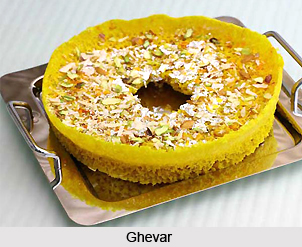 Ghevar is a Rajasthani sweet popular in various states of India like Uttar Pradesh, Haryana, Delhi, Gujrat, and Madhya Pradesh to name a few. It is traditionally associated with the Teej Festival.
Ghevar is a Rajasthani sweet popular in various states of India like Uttar Pradesh, Haryana, Delhi, Gujrat, and Madhya Pradesh to name a few. It is traditionally associated with the Teej Festival.
Ghevar is disc-shaped and comes in various types such as plain, mawa and malai ghevar. It can be found in the market during the Saavan month of Hindus which falls in (approx) July and August. Ghevar is also served in the weddings of Rajasthan.
Ingredients of Ghevar
•3 cups plain flour
•1 cup solidified ghee
•3-4 ice cubes
•4 cups water, approx.
•1/2 cup milk
•1/4 tsp. yellow food colour
•1 kg. Ghee for deep frying
For syrup:
1 1/2 cup sugar
For topping: (optional)
•1 tsp. powdered cardamom
•1 tbsp. chopped almonds and pistachios
•1 tbsp. milk in which 1/2 tsp. saffron has been already mixed
•Silver foil
Method of Preparing Ghevar
•Prepare sugar syrup of 1 thread consistency.
•Taking one ice cube at a time rub the ghee vigorously. Take more ice cubes as required, till ghee becomes very white.
•Add milk, flour and 1 cup water. Mix to make smooth batter.
•Dissolve colour in some water and add to batter. Add more water as required. Batter should be fairly thin.
•Take an aluminium or steel cylindrical container. Fill half with ghee.
•Heat till ghee is smoky hot.
•Take a 50 ml, glassful of batter. Pour in centre of ghee, slowly in one continuous threadlike stream.
•Allow foam to settle.
•Pour one more glassful in hole formed in centre. When foam settles again, loosen ghevar with an iron skewer inserted in hole. Lift carefully, at a slant, and place on wire mesh to drain.
•Keep hot syrup in a wide flat bottomed container to fit in ghevar.
•Dip ghevar in it, and remove, keep aside on mesh to drain excess syrup.
•Top with silver foil.
•Splash a few drops of saffron milk, sprinkle some chopped dry fruits and a few pinches of cardamom powder.




















